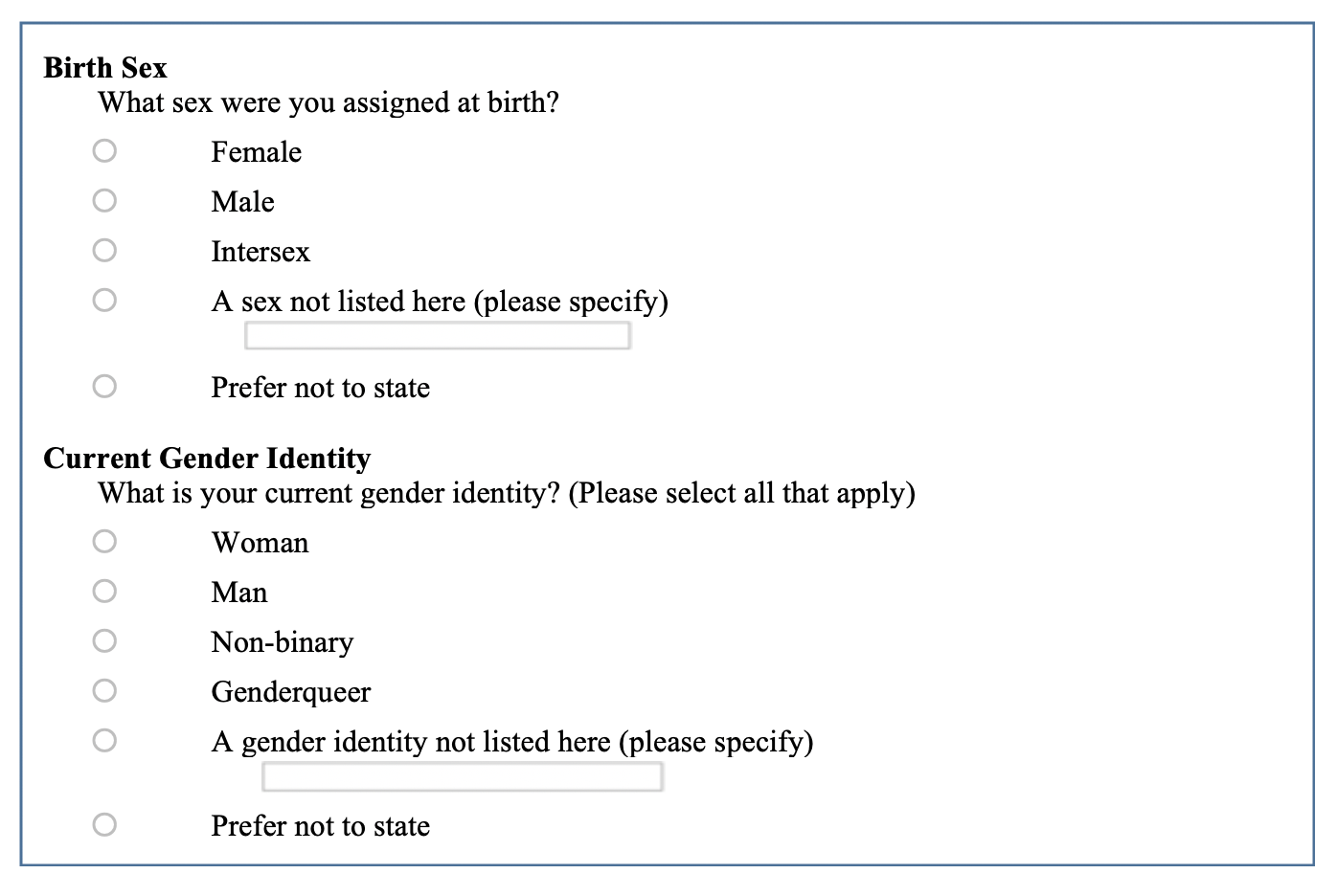Most survey questionnaires in the social sciences, health sciences, civil engineering, city planning, include a demographic question about sex or gender. Traditionally, survey-based items about sex or gender have asked respondents to indicate whether they are male or female (Box 1). This method, however, has been criticized for failing to capture the complexities of sex and gender identities. Conflating birth sex and gender identity in questionnaires can lower the precision and relevance of survey research for policy development and innovation.


Works Cited
Deutsch, M. B., Green, J., Keatley, J., Mayer, G., Hastings, J., Hall, A. M., ... & Blumer, O. (2013). Electronic medical records and the transgender patient: recommendations from the World Professional Association for Transgender Health EMR Working Group. Journal of the American Medical Informatics Association, 20(4), 700-703.
Factor, R., & Rothblum, E. (2008). Exploring gender identity and community among three groups of transgender individuals in the United States: MTFs, FTMs, and genderqueers. Health Sociology Review, 17(3), 235-253. Fraser, G. (2018). Evaluating inclusive gender identity measures for use in quantitative psychological research. Psychology & Sexuality, 9(4), 343-357. GenIUSS Group (2014). Best practices for asking questions to identify transgender and other gender minority respondents on population-based surveys. Los Angeles: Williams Institute. Jans, M., Grant, D., Park, R., Kil, J., Viana, J., Lordi, N., ... & Herman, J. L. (2015). Using verbal paradata monitoring and behavior coding to pilot test gender identity questions in the California Health Interview Survey: the role of qualitative and quantitative feedback. In Proceedings of the American Association for Public Opinion Research Annual Conference. Magliozzi, D., Saperstein, A., & Westbrook, L. (2016). Scaling up: Representing gender diversity in survey research. Socius, 2, 1-11. Melendez, R. M., Exner, T. A., Ehrhardt, A. A., Dodge, B., Remien, R. H., Rotheram-Borus, M. J., ... & National Institute of Mental Health Healthy Living Project Team. (2006). Health and health care among male-to-female transgender persons who are HIV positive. American Journal of Public Health, 96(6), 1034-1037. National Academies of Sciences, Engineering, and Medicine. (2022). Measuring sex, gender identity, and sexual orientation. Washington, DC: The National Academies Press. https://doi.org/10.17226/26424 Nielsen, M. W., Stefanick, M. L., Peragine, D., Neilands, T. B., Ioannidis, J. P., Pilote, L., ... & Schiebinger, L. (2021). Gender-related variables for health research. Biology of sex Differences, 12(1), 1-16. Pilote, L., & Karp, I. (2012). GENESIS-PRAXY (GENdEr and Sex determInantS of cardiovascular disease: From bench to beyond-Premature Acute Coronary SYndrome). American Heart Journal, 163(5), 741-746. Reisner, S. L., Conron, K., Scout, N., Mimiaga, M. J., Haneuse, S., & Austin, S. B. (2014). Comparing in-person and online survey respondents in the US National Transgender Discrimination Survey: Implications for transgender health research. LGBT Health, 1(2), 98-106. Saperstein, A. and Westbrook, L. (2018). Categorical and continuous: Testing multiple alternative measures of sex and gender in U.S. surveys. Conference paper presented at “Gender Diversity in Survey Research, 06.11.2018, University of Gothenburg. Scheuerman, M. K., Paul, J. M., & Brubaker, J. R. (2019). How Computers See Gender: An Evaluation of Gender Classification in Commercial Facial Analysis Services. Proceedings of the ACM on Human-Computer Interaction, 3(CSCW), 1-33. Tate, C. C., Ledbetter, J. N., & Youssef, C. P. (2013). A two-question method for assessing gender categories in the social and medical sciences. Journal of Sex Research, 50(8), 767-776. Westbrook, L., & Saperstein, A. (2015). New categories are not enough: Rethinking the measurement of sex and gender in social surveys. Gender & Society, 29(4), 534-560.




